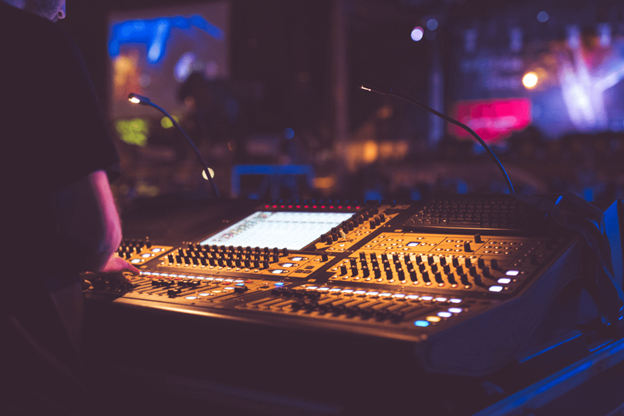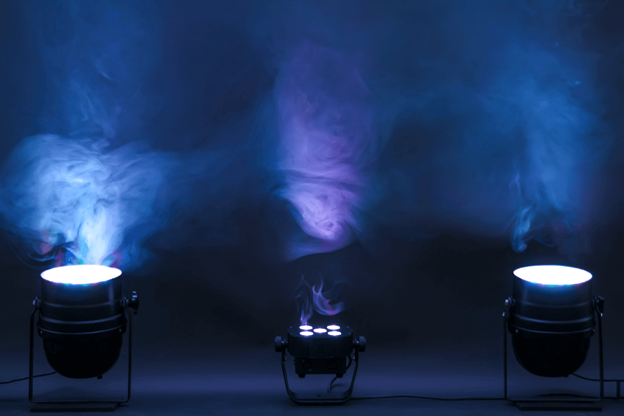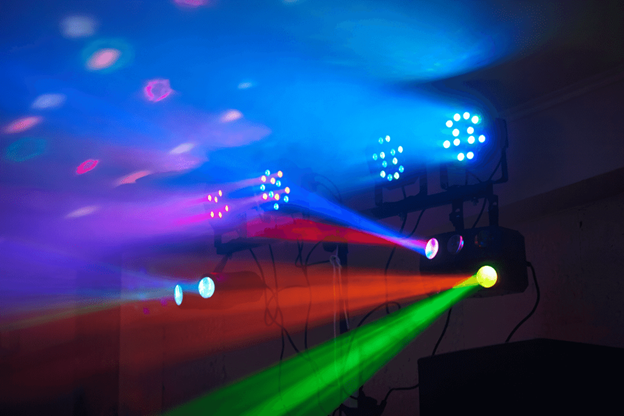 As any fan of live entertainment knows, a set needs to communicate with the crowd to enhance the experience. It is the kind of connection that wins fans and keeps people coming back to shows. If a performer has been traveling without a lighting setup, then they are missing some important aspects of connecting with a crowd.
As any fan of live entertainment knows, a set needs to communicate with the crowd to enhance the experience. It is the kind of connection that wins fans and keeps people coming back to shows. If a performer has been traveling without a lighting setup, then they are missing some important aspects of connecting with a crowd.
Stage lighting affects how the crowd feels and helps create a unique atmosphere for your performance. However, for a lot of DJs and live performers, lighting controls are an intimidating hurdle to clear. That’s why we’re here to show you how you can easily create impressive lighting effects using a DMX.
Using a DMX controller, technicians can synchronize lights to their performances, use different types of lighting fixtures, and even incorporate other devices like fog machines to take their performance to the next level. If you are interested in learning more about how DMX lighting works, keep reading!
What is DMX?
DMX is the protocol used by the controller to create complex stage lighting

A lot of people are hesitant to start learning about lighting controls because it looks very complicated. While these lighting commands certainly look complex on the stage, they are actually fairly easy to execute.
DMX stands for Digital Multiplex and is a protocol for controlling stage lights and other devices meant for stage—like fog machines. Using the DMX software, lighting techs can input commands that the controller then carries out on stage. The DMX controller transmits the commands down the chain of lighting fixtures with a limit of up to 512 channels.
You will often see DMX protocol referred to as DMX 512 in a reference to the number of channels allowed in a single DMX “universe”. Each channel represents a command. For example, if you are using the three basic colors—red, green, and blue—those colors represent three channels.
If you are just getting started learning about lighting, there is no need to worry about reaching the limit of 512 channels. Using the DMX, lighting techs can create different channels that correspond to different light fixtures used in the show.
Working with DMX: Daisy Chaining
Create coordinated light shows by linking the fixtures together and to the DMX controller

For the next step, it’s time to apply the rules you established with your DMX controller across different fixtures. By connecting several fixtures to the same chain, lighting techs can create coordinated lighting patterns that are impressive for any audience.
In order to create the kind of lighting patterns audience members expect from live performances, several fixtures need to be attached to the same “daisy chain” of DMX cables transmitting commands to the fixtures. To achieve this effect, you need to designate a master fixture that acts as a lead to all of the others in the chain.
After that, simply connect the DMX cables and the rest of the compatible lighting fixtures will mimic the master fixture. Overall, chaining these fixtures together is your first step toward creating an exceptional lighting layout for a live performance. By chaining these fixtures together, the effect is far greater than what is expected from simply connecting a few lighting fixtures to cables.
What Does a DMX Control?
DMX controllers allow for an almost unlimited amount of color options and lighting patterns

Using DMX protocol, technicians can dictate extremely specific commands. This is true for both colors and lighting patterns. Even if you are using one of the most basic LED lighting fixtures in your setup, you will still be able to create almost any color.
Using LED fixtures—which are industry standard—technicians can try out color mixing to make sure they get the exact color to suit each element of a live performance. Color mixing is a fairly simple process when using a DMX controller. All users have to do is designate a brightness level to each of the different base colors—red, green, blue, amber, and white.
By adjusting the brightness of each of the base colors, you can get the exact color you want for a live performance. Once you have your color mixing taken care of, you can move on to lighting commands. Lighting commands can be anything from a strobing effect to the swivel of a moving headlight.
Beyond color, these are the type commands that require the additional channels allowed by the DMX. These lighting commands also depend on the compatibility of the lighting fixtures you are using. We highly recommend using a combination of changing colors, sound activated/preset commands, and other DMX inputs to create a constantly changing and immersive experience for the audience.
Once you have preset some lighting commands for your show, all you have to do is queue up the commands in the order you want them to display. These present commands are commonly referred to as “scenes”. So, once you have established your scenes, it is fairly easy to arrange them to create a complete light show.
What Are the Different Types of DMX Controllers?
The type of controller you use will depend on how you prefer to control the lights on stage

We’ve talked about how DMX works, but did you know that there are two different types of DMX controllers? The two major types of DMX controllers that you should know about are hardware and software. The great thing about these two varieties is that they both have the same capabilities, they really only differ in the way that they receive inputs.
If you are just getting started operating lighting controls for a show, we recommend trying out both ways before you choose which one is best for you.
Hardware DMX Controllers
A hardware controller is the more traditional method of lighting control. The hardware DMX looks like a large box—almost like an audio mixing board. Since most people who work in live entertainment are familiar with a mixing board, it isn’t too difficult to make the jump to a DMX.
When using a hardware DMX, you can control the different scenes by manually adjusting the sliders on the console. Using the sliders, you can mix in different preset lighting scenes to create an exciting light show.
A lot of people prefer working with a hardware DMX because there is something tangible to adjust. The feeling of the manual controls helps some lighting technicians put on better shows and gives them a better feel of the different lighting scenes.
A hardware DMX also has a distinct advantage over software DMX—dependability. In some cases, an error can occur with software that will cause problems in the lighting output. A hardware DMX is far less error-prone.
Software DMX Controllers
Though we just mentioned how software DMX systems can be prone to errors, there are a lot of positives when it comes to using a software DMX. For one, you can add applications to your software DMX program for effects that are complicated or impossible to create with a hardware control system.
It is also far easier to get a big-picture idea of a complete light show using the software. Using the software, you can easily create a virtual environment by arranging different scenes and transitions ahead of time, which means that there is far less work once the show begins. DMX software also allows for more agile controls as opposed to the hardware options.
Is it Possible to Put on a Light Show Without a DMX?
While there are ways to create a light show without a DMX, the options are limited

If you are searching for an easy way to add lights to a performance without having to learn DMX protocol, there are a few options out there! If all you need are lights that will respond to the beat of the music, you can search for sound activated LED lights. All these lights will do is pulse on an audio cue using a single predetermined color.
While this is not applicable to larger shows, this type of lighting works well for someone who is getting started and wants some simple lighting effects. There are also some programs that allow users to program simple ambient lighting controls to fill in any gaps in the stage. While these lights won’t move with the music, they add additional mood and ambiance to a performance.
Wrapping it Up:
And there you have it—all of the basics you need to get started using a DMX for live performances! While there is a bit of a learning curve no matter if you are using a hardware or software DMX, the controls are fairly simple once you get the hang of it.
The great thing about DMX is that it can be applied to the smallest or largest stages, so there’s really no limit to the lighting creativity that you can explore with this technology!















Great Content,
Very informative content .Using DMX lighting in performances enhances the visual experience, allowing for dynamic and synchronized light shows that complement the music or event atmosphere. It adds a layer of creativity and control, enabling lighting designers to craft immersive and memorable experiences for audiences.